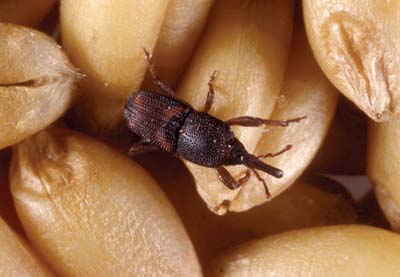
Adult rice weevil, Sitophilus oryzae, on wheat.
(Photographer: L.J. Buss, University of Florida)
The rice weevil is considered one of the most important grain pests. It is primarily a pest in warm countries, and in the U.S. is more important in the southern states. It has been reported on beans, nuts, cereals, wheat products, and grapes. In northern states, infestation begins when new grain is stored in bins, warehouses or silos. It is worldwide in distribution.
The rice weevil is a snout beetle, in that it has its mandibles at the tip of a long snout. This weevil is dark reddish brown with two light markings on each wing cover. The deep punctures on the pronotum are round. The insect is 2.5 to3.5 mm in length. This beetle resembles the granary and maize weevils, but has different markings on the forewings. Also, unlike the granary weevil, the rice weevil has well developed wings and can fly to spread infestations. Females lay 300 to 400 eggs and the egg, larva, and pupa stages are completed inside grain kernels and are rarely seen. The life cycle can take as little as 32 days for completion and the adults can live three to six months.
Images
To save the Web-optimized images shown below to your hard drive:
|
Click to access Display and Print quality images. |
|
Click to access Display and Print quality images. |